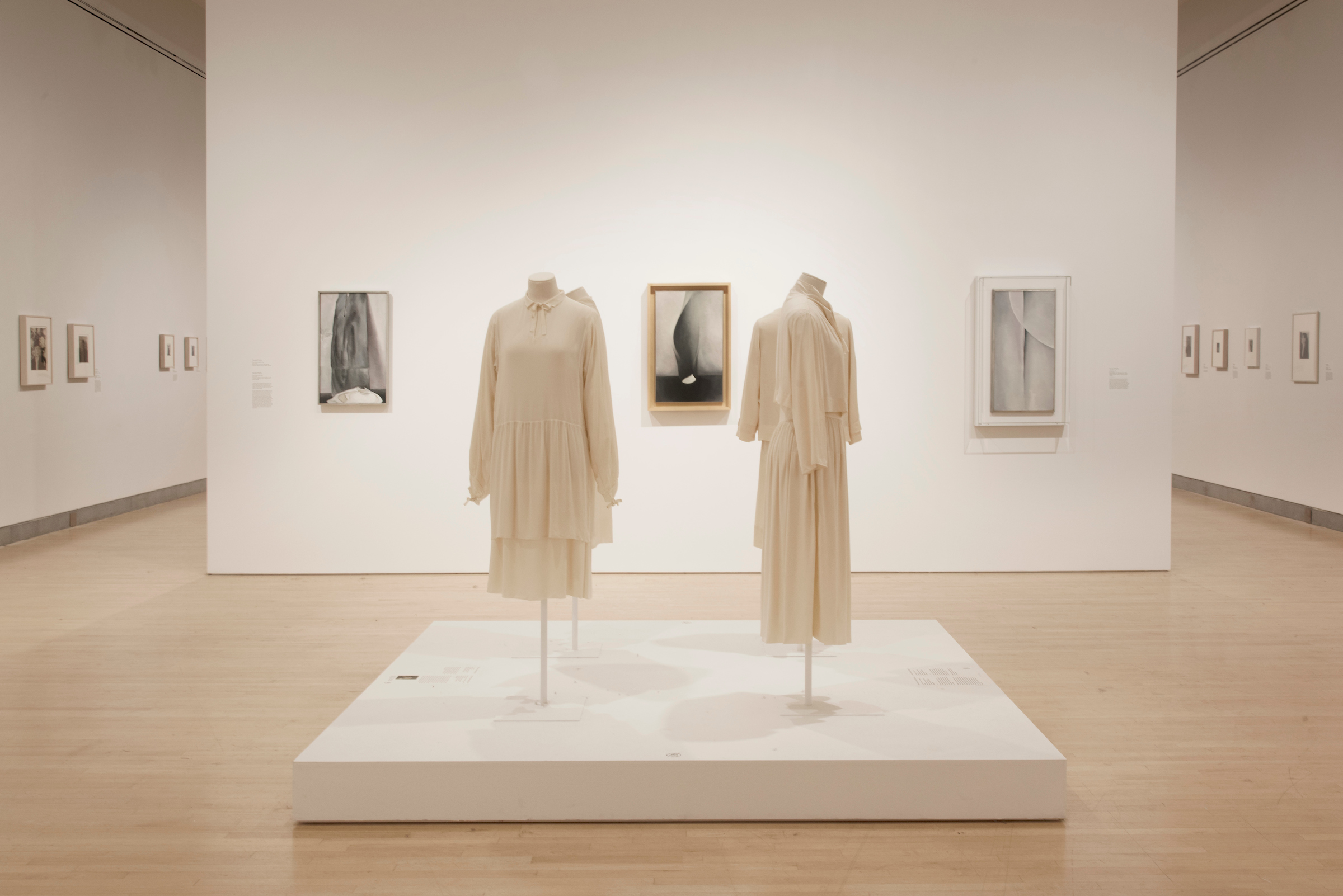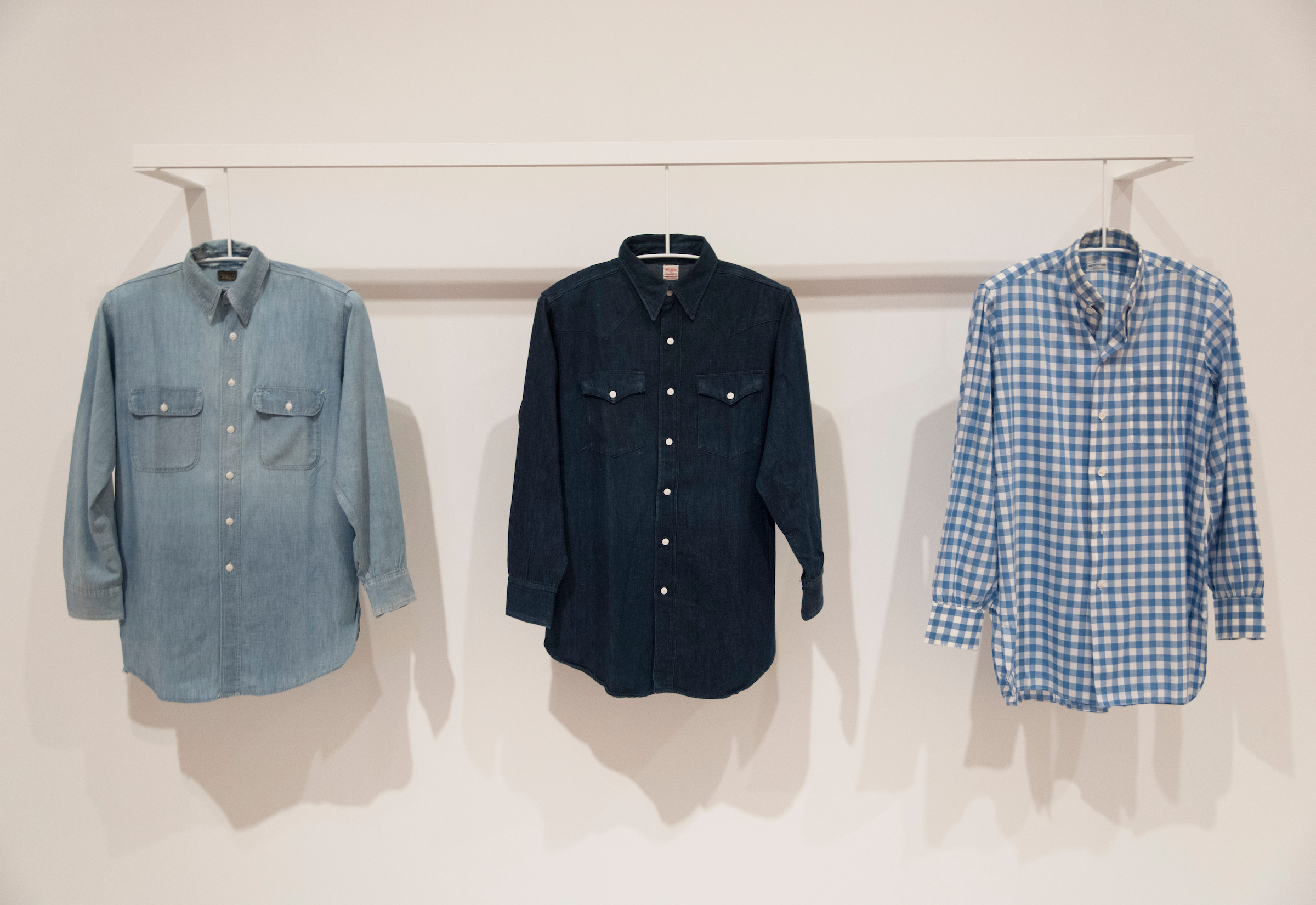Georgia O'Keeffe: Living Modern
The Brooklyn Museum (March 3 - July 23, 2017)
While the painter Georgia O’Keeffe was famed for her detailed renderings of oversized flowers, colorful southwestern landscapes, and modernist murals she is now becoming known for her tailored black skirt suits, rainbow of cotton wrap dressed, and well-worn jeans. Through a recent exhibit, O’Keeffe is being repositioned as a sartorial innovator and one of the originators of self-image creation. O’Keeffe is best known for her detailed paintings of natural elements like flowers and shells. While these artworks were often interpreted by critics as referencing female anatomy, O’Keeffe vehemently denounced this reading; instead, she felt her work was a naturalist, modernist response to the industrialized, mechanized world of the early 20th century. She said she had to “paint the flowers huge, so that people would have to look at them.” But O’Keeffe also seemed to know that her painted flowers were not all that people would want to look at—by posing for hundreds of portraits by master photographers wearing carefully chosen and rigorously styled clothing, O’Keeffe also made herself into an object d’art.
The Living Modern exhibition at the Brooklyn Museum, installed from March 3 – July 23, 2017, analyzed the relationship between O’Keeffe’s clothing and artistic output. Curated by Wanda M. Corn, with a superbly researched accompanying catalogue, Living Modern brilliantly wove together the disciplines of art history, material culture, and fashion studies as it delved into O’Keeffe’s life work. It did so by pairing clusters of garments from O’Keeffe’s wardrobe alongside her paintings and portraits of her taken by her photographer husband Alfred Stiegletz, as well as Irving Penn, Bruce Weber, Ansel Adams, and several other luminaries of the medium. In these pictures, O’Keeffe is seen as strong and often genderless, at once ever-changing and consistently reiterating her stylistic imprint. There is often a monastic quality to the portraits—over and over again she is seen in meditative poses, her head covered by a dark cloth or hat and often wearing a white scarf or collar—but glimpses of her complex personality are sometimes captured: playfulness when peering through a slice of Swiss cheese, or smiling slightly while stirring a stew, for example.
O’Keeffe was born in 1887 and raised, along with six siblings, in Wisconsin and Virginia at a moment when the socio-cultural climate required her to dress according to the standards of Edwardian and Victorian ornateness: floor length skirts with frills and lace, tight bodices, and long sleeves, all paired with puffed-up pompadour hair. After high school, she studied art in Chicago and New York, but was not able to obtain a certificate due to family finances. As a student, she was exposed to Eastern art—as well as Eastern thought and dress—which had a profound impact on O’Keeffe’s aesthetic sensibilities.
After her time in art school, O’Keeffe began teaching art to support herself, accepting positions in Virginia and Texas. While in Texas, she began to develop her own standards of dress: wearing flat shoes and shapeless black dresses with little ornamentation beyond a few buttons, and a contrasting white V neckline. In 1917, several of O’Keeffe’s drawings were shown by Alfred Stieglitz in his New York gallery, and O’Keeffe went to see her show. Stiegletz and O’Keeffe quickly fell in love, and she moved to New York the following year, giving up teaching and dedicating herself to painting.
A group of handmade garments believed to be made by O’Keeffe herself accompanies her paintings and portraits from the early years of her life, many of which were put on mannequins so viewers could view each one in the round. A high level of craftsmanship and attention is evident in these garments: miniscule pintucks for texture, delicate ruffles add a subtle flourish, precise faggoting creates visual intrigue. All the clothes: linen blouses, silk dresses, and wool jackets are either black or white. O’Keeffe felt, at that time, that a monochrome dress scheme let her focus on the colors in her paintings. In her later years, though, O’Keeffe did wear color—she just almost never let herself be photographed in the adobe pink and Persian blue tops, red and purple plaid dress made of Madras cotton, or Marimeko dress with teal stripes that hung in her wardrobe. Also on display in the exhibition were pieces from O’Keeffe’s adopted Western uniform: Levi’s jeans, printed bandanas, and button-down shirts—in denim, gingham, and chambray—and simple cotton and rubber sneakers. These were the clothes she would wear when at her New Mexico ranch, the place she spent most summers from 1929 on, and permanently relocated to in 1946. The New Mexican landscape is almost synonymous with O’Keeffe, and her adobe home in Abiquiu is another expression of her modernist vision.
When modern designers began expressing the sartorial guidelines O’Keeffe had already established for herself—like Claire McCardell for Townley frocks, Annika Rimala for Marimekko, and Cristobal Balenciaga for Eisa—she populated her closet with iterations of their designs: belted dresses with small bows at the neck, button down dresses with large patch pockets on the front, back skirt suits with white blouses. O’Keeffe also leaned on the Eastern influences that shaped her painting and sculpture in her dress practice: she owned several kimonos, used a changpao as a painting smock, and had a tailor from Hong Kong stitch up a few dresses and suits for her.
O’Keeffe’s philosophy believed that every aspect of one’s life should have a unified aesthetic, and that this practice fulfilled a spiritual need. She summed her life’s purpose up as “filling space in a beautiful way”; from the blank white of a canvas to the form of her body to the walls and floor of a home—all these spaces became places where O’Keeffe’s formalism, modernism and naturalism could be practiced. The exhibit stresses the integration of each of these areas, effectively positioning O’Keeffe as a ‘lifestyle’ pioneer. But while the current concept of lifestyle is conflated with the concept of conspicuous consumption, O’Keeffe embodied a very different vision. “Something just hit me about the way she lived,” said Annie Leibowitz. “Her frugality—all of her linens were frayed—is a reminder that we don’t need much. She had a simple life: she worked every day, grew a vegetable garden, and ate well.”
O’Keeffe also dressed well. Simply, but very well.
Throughout the exhibition, the curator noted elements of O’Keeffe’s dress practice that can be seen as guidance for a building a sustainable wardrobe today. For materials in her clothing, O’Keeffe always favored natural textiles like linen, cottons, wools, and silks over synthetics, even during the mid-century decades when synthetics became widely popular and were seen as being easier to wash and wear than natural fibers might be. In terms of cuts, O’Keeffe found silhouettes that worked well on her body, and had multiples of the same garment made over for her by a seamstress in several different fabrics. Many of the pieces of O’Keeffe’s that were on display showed signs of being mended in places where they became torn or threadbare. She was also known to bring a new life to used clothing: one piece of clothing in the exhibit was accompanied by a note from O’Keeffe to New Yorker critic Murdock Pemberton thanking him for sending her his old button-down shirt, saying that she “wore it with great pleasure” and asking him to send her more of his sartorial discards.
O’Keeffe once wrote that “to create one’s own world in the arts takes courage.” This exhibit reminds us that to create one’s own world of dress takes courage, also. Georgia O’Keeffe’s life acts as an inspiration, and a testament to the fact that such creation—in both worlds—is possible.



